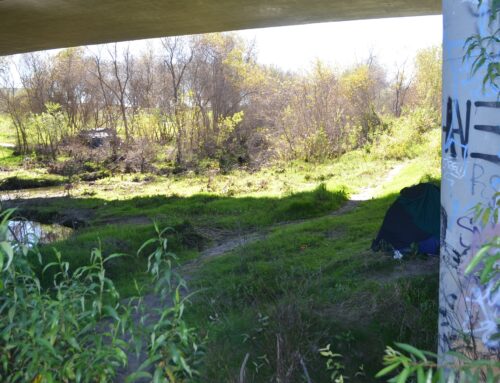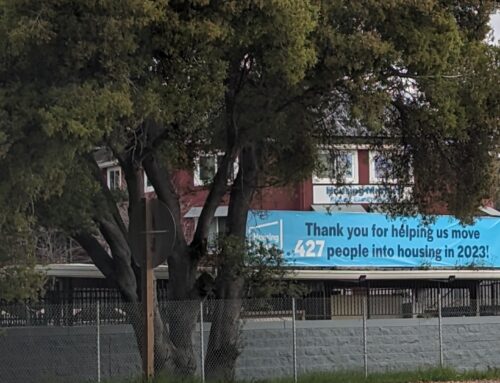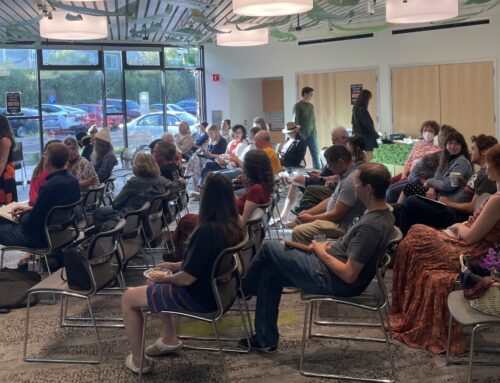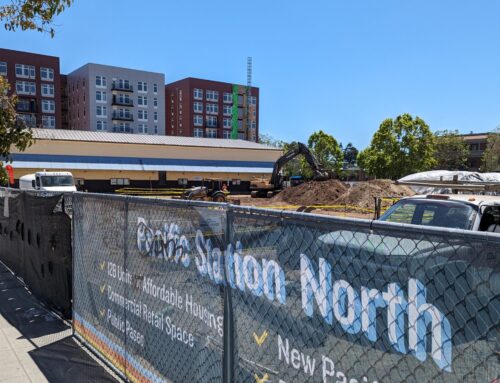
SANTA CRUZ >> A new transitional camp, a portable toilet at the San Lorenzo River footbridge, and longer hours for public bathrooms – these were some public health solutions offered by the public at a city listening session on homelessness Tuesday night.
About 30 people attended the meeting at Harbor High, hosted by the City of Santa Cruz Community Advisory Committee on Homelessness.
The Santa Cruz City Council formed the committee in June to guide city policy on homelessness. Tuesday’s meeting was the first of possibly several community listening sessions. The topic was public health and hygiene.
The committee already has generated some ideas to improve public health and hygiene in the short term, such as the addition of two portable toilets downtown and the creation of an RV sewage dumping site in the city.
The committee’s goal Tuesday was to get ideas from the public, and incorporate feasible solutions into the committee’s presentation to the city council. The committee will deliver a series of initial recommendations at the Dec. 10 city council meeting.
Its next community listening session is 6 p.m. Tuesday Dec. 17 at the Veteran’s Memorial Building, 846 Front St. in Santa Cruz. The topic is safe sleeping and camping. Part of the committee’s work is to identify possible sites and siting criteria for a new homeless camp. The committee also hopes to find a new spot for the 1220 River St. Camp, which closes in March.
Committee member Rafael Sonnenfeld said his subcommittee, in charge of finding solutions for safe sleeping, has considered several possibilities but has not found clear options for sites – not yet, anyway.
“It’s hitting a moving target,” Sonnenfeld said.
PUBLIC INPUT
Tuesday, attendees formed small groups to discuss fears and challenges related to homelessness and public health. Moderators took notes with markers on butcher paper.
Attendees also discussed local successes related to homelessness, public health and hygiene. Examples included:
- The Warming Center Program’s volunteer-run emergency shelter, storage and laundry programs
- New 24-hour access to the portable toilets at Housing Matters
- Increased public access to City Hall restrooms this year.
Finally, on Post-it notes, attendees wrote ideas for public health solutions. People cast votes with colored stickers on their top three choices. Popular ideas included:
- Increase access to showers by offering vouchers to gyms or hotels
- Assemble an inventory of empty buildings in the city
- Increase the number of public health workers
A few attendees were skeptical that Tuesday’s listening session would solve much.
Homeless activist Lucero Luna said she’s attended similar sessions.
“I call these things ‘cookie cutter,’” Luna said. “It doesn’t matter what city or county you’re in. They’re all the same and they don’t do —-.”
Marcus Givens offered a different view. Givens is director of Dignity on Wheels, an East Palo Alto-based nonprofit that offers mobile showers and laundry service at locations across the Peninsula. He was invited by the committee to attend Tuesday and present his work on public health and hygiene.
Givens said Tuesday’s listening session was an example of how communities can move past opposition to new sites for services for homeless people.
“What you’re doing right now, this is the solution, honestly,” Givens said. “Sometimes people have fears that are based on a real bad experience that they had. Sometimes people have fears that are based on their assumptions about their unsheltered neighbors and they’re not correct…
“We try to tell them the truth. But we also give people an opportunity to let people tell [us] that we’re crazy. We don’t agree with them, but that’s fine. We’re going to keep doing it. So yeah. Let people talk,” Givens said.
NEXT STEPS, CAMPING LAW
City leaders want to update the city’s ban on camping in public spaces. They want to make it easier for police to clear homeless camps that are a nuisance on public property. The federal court case Martin vs. Boise limits how cities can enforce camping bans. The court ruled that cities can’t enforce camping bans when there aren’t enough shelter beds.
The city’s proposed update was prompted by a homeless camp that appeared Nov. 10 at Highway 1 and River Street – where the Ross Camp was earlier this year. That new homeless camp was dispersed by police Nov. 15, but only after city leaders determined that the group was trespassing.
The proposed update only allows police to ticket homeless people for nighttime camping if police offer a shelter bed and the person refuses it.
There are two issues with that part of the proposal:
- Police don’t have a way to check in the middle of the night whether shelter beds are available, the city attorney has said.
- The city also doesn’t have on-call shelter beds that police can send homeless people to in the middle of the night after regular shelter intake closes, the city manager has said.
The city council, at its Nov. 26 meeting, voted unanimously to have the homelessness committee review a proposed update to the city’s camping law by January.
Tuesday, the committee decided to ask the city council for more time. The committee wants to identify possible locations for people to sleep before the law is enacted.
Committee member Don Lane, who made the initial version of the motion, said that the city council is pushing the update without dealing with the problem.
“Why bother rushing on the ordinance and not being able to enforce it?” Lane said.
Read Santa Cruz Local’s related stories on the proposed updates to the camping law:
Santa Cruz council delays new rules for homeless camp closures (Nov. 27)
Santa Cruz law change in the works to handle homeless camps (Nov. 20)
Kara Meyberg Guzman is the CEO and co-founder of Santa Cruz Local. Prior to Santa Cruz Local, she served as the Santa Cruz Sentinel’s managing editor. She has a biology degree from Stanford University and lives in Santa Cruz.










